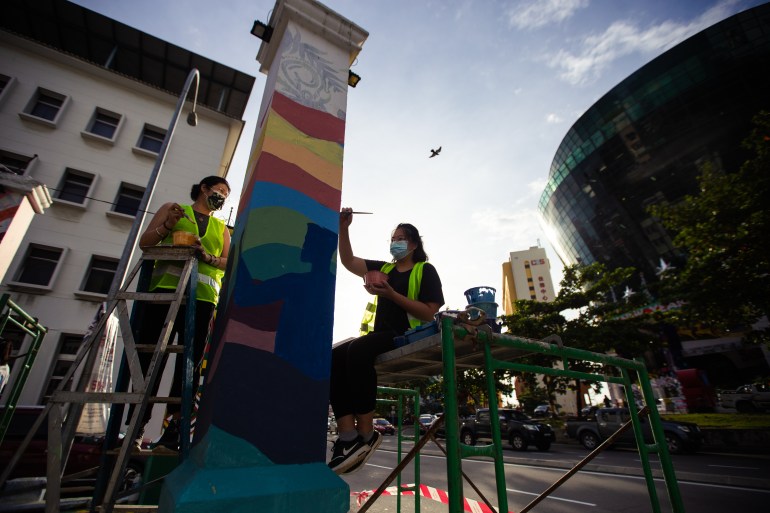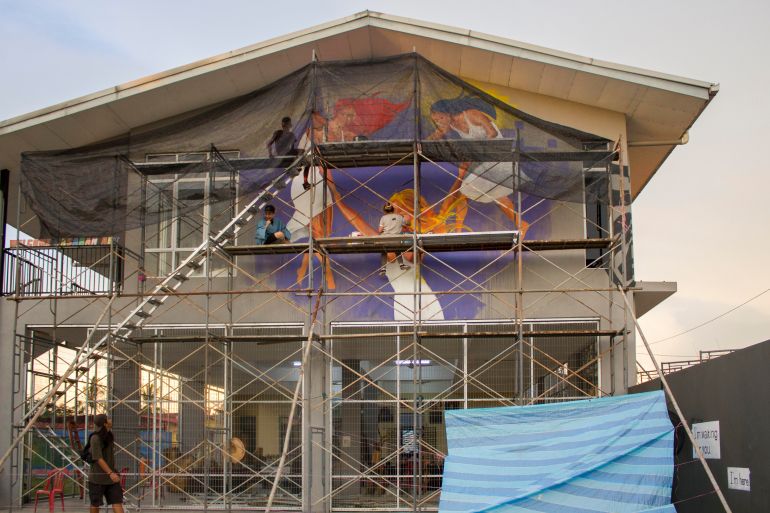Malaysian arts jostle with draconian laws, conservative attitudes
Arrest of prominent graphic artist Fahmi Reza over a music playlist has rekindled debate over freedom of expression.

George Town, Malaysia – The arrest of graphic artist and social activist Fahmi Reza over a satirical song list poking fun at a comment made by Malaysia’s queen has rekindled debate over freedom of expression in the Southeast Asian nation.
Police arrested Fahmi, who came to prominence in 2015 with a now iconic clown caricature that lampooned then-Malaysian Prime Minister Najib Razak, on April 23, accusing him of insulting the queen with the playlist, which he titled Dengki Ke (Malay for “Are you jealous?”) and illustrated with a cover image of the royal.
Keep reading
list of 4 itemsMalaysia’s Najib Razak faces bankruptcy over $400m tax bill
N Korea to cut ties with Malaysia over US extradition ruling
Malaysia cites COVID-19 misinformation with new ‘fake news’ law
He was also accused of sharing “offensive and menacing content” for the list, which he uploaded to Spotify and Apple Music, featuring songs including Jealousy by Queen and God Save the Queen by the Sex Pistols.
The queen, Tunku Hajah Azizah Aminah Maimunah Iskandariah , had come under fire earlier for saying: “Are you jealous?” to an Instagram user who questioned alleged privileged access to COVID-19 vaccines on her personal Instagram account.
Hot on the heels of 44-year-old Fahmi’s arrest, award-winning political cartoonist Zunar also found himself under investigation – for a caricature of a state chief minister that he published in January.
The two cases have put censorship back in the spotlight in a country where the freedom to be creative has long been hobbled by restrictive laws, as well as political, religious and cultural sensitivities.
Most people in Malaysia are ethnic Malays who are Muslim but there are also large communities of ethnic Chinese, Indian and Indigenous people who follow other religions and beliefs.

“There’s always a limit when a piece is meant for public viewing, whether it’s a mural, sculpture, performance or installation,” said Bibichun, a leading visual artist based in UNESCO world heritage site George Town, on the northwestern island of Penang.
Before the coronavirus pandemic, the city was a magnet for tourists who came in droves to view the street art that began to spread across buildings and alleyways after Lithuanian artist Ernest Zacharevic painted six murals there in 2012 and captured the public imagination.
A projected eight million tourists were expected to visit the island in 2020 before movement curbs were imposed, providing valuable income for artists like Bibichun who make most of their money from commissioned murals, which start at a minimum of RM1,000 ($243) per piece.
“Sexy, racial and political artworks are not allowed,” said Tan Chor Whye of Can Can Public Art, a Penang organisation that commissions artists to revitalise urban spaces with street art. “If a project is supported by the state government there’s more control on subjects, while individual funders allow more freedom but you still need to consider the authorities and the comments of the community.”
Even heritage bodies and religious agencies sometimes have a say about what they can paint.
“Simply put, just paint pretty, Teletubbies-like happy pictures, or the public will go nuts,” said Bibichun. “Opposition propaganda would be suppressed before it can even start.”
An underground graffiti scene is still continuing but artists risks being prosecuted for breaking the law and are not paid for their work.
Conservative mindset
Since murals help attract tourists and enliven the city’s streets, they are in demand even in small towns like Sasaran, a west coast fishing village just over an hour’s drive from Kuala Lumpur.

It is here that Bibichun and two other commissioned Penang-based artists, Sliz and his trainee Lyana Leong, came under fire for two pieces they painted on the walls of the Sasaran Arts Community Hall.
“Our aim is to bring arts into our community, so that people in the countryside may see and learn about art,” said Ng Bee, chairman of the commissioning Sasaran Arts Association, which has organised a string of art festivals in the past few years.
Sliz and Leong’s mural was supposed to be three women in vests holding hands, loosely inspired by The Dance by French painter Henri Matisse.
But on April 19, before the two artists could even complete the basic skin tone and shape of the three bodies, some Sasaran residents had taken to social media to lament that the “naked” figures offended religious sensitivities and could incite racial hatred among Malaysia’s different ethnic groups.
“I noticed that it was mostly ethnic Malays who commented against us,” said Lyana Leong, 24, who is part Chinese, part Malay and comes from Penang. “Maybe they are not very educated about arts, and thought that it’d be inappropriate for children to see our artwork.”
Malay artist Sliz says that rural communities in Malaysia may be most prone to be offended. He is disappointed that those who were upset about the work did not even bother speaking to the artists about it.
“If you see something you think is wrong in your area, make calculated, rational actions. Writing a ‘triggering’ racial/religious Facebook post is not. Passers-by could have approached us to ask any questions, since they had the time to take a photo and start online hate speech.”


After Sliz and Leong adjusted their mural, Bibichun found himself under attack for the rainbow he was painting on the hall’s entrance as people on social media criticised him for “supporting the LGBTQ community”, a group who are still shunned and policed in Malaysia.
Ng did not pinpoint any particular ethnic group for the comments.
He said that the villagers and the local government always supported Sasaran’s activities, which “helped promote local tourism.”
Risky interdependence
Malaysian artists also have to contend with regulation by government bodies and often work closely with other agencies that provide funding and space.
Last month, Sabah Art Gallery was criticised after pulling 31 murals in central Kota Kinabalu, the capital of the Borneo state.
Painted by different artists on the columns of a dilapidated 1920s heritage building, the pieces were unveiled on 20 December last year as part of the third edition of an open-air art installation called Pillars of Sabah (POS).
But this year Sabah Art Gallery, which claims ownership of the heritage site, went ahead “without any warning or explanation” to prepare the space for an upcoming project, POS co-founder Jared Abdul Rahman told Al Jazeera.

“We don’t mind what’s coming next, we just wanted to be informed. Sabah Art Gallery owns the site but gave us permission to use it for our project, which is funded by CENDANA, a national arts funding agency. It has deliverables which now we cannot entirely fulfill.”
The issue concluded after some online debate on April 29, when Sabah Art Gallery posted a public apology on their Instagram page.
“The arts community should start its own support system,” Jared said. “We need to stop such heavy dependence on the government, especially when they don’t have the artists’ interests at heart.”
The gallery’s director Jennifer Linggi did not respond to Al Jazeera’s request for comment.
Few Alternatives
“Renting commercial spaces is also prohibitive, and COVID didn’t help,” said Penang artist Timothy Chan, 24, who juggles commissions with running the small OTW Gallery he co-founded with Fakhrur Razi Maricar inside Soundmaker Studio, George Town’s only underground music space.
OTW opened in April with a group exhibition called Faded, featuring works by artists including Sliz and Bibichun. Sales from the exhibition may help them keep afloat but with a limited market outside of the capital and domestic tourism restricted by interstate travel bans, murals remain the quickest way to earn a buck.
“What happened in Sasaran is a question of mentality,” said Chan. “Murals are a reflection of what artists see and shouldn’t be frowned upon that much. I believe there is still room for Malaysian mural artists to learn from the experience and grow.”
Investigations and seizing of @kuasasiswa‘s account is just another form of harassment and intimidation – Stop this now!#satireisnotacrime https://t.co/9YtC7R8vPS
— ARTICLE 19 Malaysia (@Article19Msia) May 5, 2021
Fahmi, meanwhile, was heading back to a police station for questioning on May 6 over two other posters he designed – including one mocking the health minister – and posted on Facebook and Twitter earlier in April.
Unlike other Malaysian artists who are prepared to negotiate restrictions for the sake of doing art, Fahmi is not backing down.
He posted on his Facebook profile on April 30 that he is “ready to face any new investigation or accusations, and ready to defend all my graphic works. As usual, I will not delete those posts. The people should not be afraid of the government, a government should be afraid of the people. […] No matter what obstacles, I will continue to fight.”